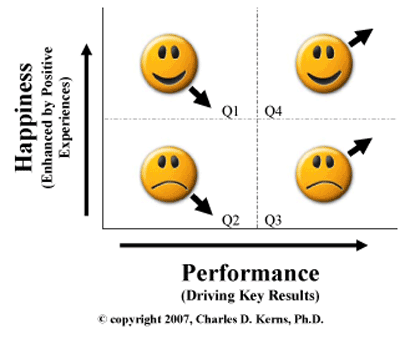Are happy workers productive workers? That always seems to be the assumption, just it always seems assumed that “better broadband produces higher economic growth.” But it that a reasonable assumption? Yes, most studies suggest. But some question the theory that happiness leads to productivity.
Industrial psychologist Fredrick Herzberg is among those who might argue the link is not as causal as most of us believe.
One issue is what we actually are measuring, though. Is it morale, engagement, employee satisfaction scores, fulfillment, or something else that is the proxy for “happiness.” Sometimes such measurements look at job satisfaction.
Other times “well being” is what researchers try to measure. By definition, well being involves not only the job, but also everything else in a person’s life. In other words, it might be possible that people are happy for other reasons, or engaged for other reasons, also are able to produce more effectively.
At least in principle, organizations might have a mix of happy, yet low-performing employees, as well as unhappy low-performing employees. Organizations might also have unhappy high performers or happy high performers.

source: Professor Charles D. Kerns
Though studies suggest all are correlated with higher productivity, the empirical results vary based on which proxy is used.
But some argue--perhaps counterintuitively--that happiness doesn’t necessarily lead to increased productivity.
“A stream of research shows some contradictory results about the relationship between happiness — which is often defined as “job satisfaction” — and productivity,” according to researchers André Spicer, professor of Organizational Behavior at Cass Business School in London and Carl Cederström professor of Organization Theory at Stockholm University.
“One study on British supermarkets even suggests there might be a negative correlation between job satisfaction and corporate productivity,” they note. The more miserable the employees were, the better the profits, they note.
But it also is fair to point out that the direct relationship between performances and positive attitudes has not been proved, at least not yet.
The belief that happy workers “must be” more productive workers is widespread. Most of us instinctively wish to believe it. The correlation might generally exist (though the causal relationship remains arguably unproved).
Correlations might be enough, though, in the sense that people act as if the statement were true, regardless of fact.
Most of us act as though “broadband causes economic growth.” Correlations obviously exist. But nobody yet has been able to prove causation, as there always are other explanations.
Places with high economic growth tend to produce wealthier and better-paid employees, who are in position to pay for better broadband. Places with high employment of knowledge or information workers likewise might also be places where demand for faster broadband is highest, both for reasons of “we can afford it” as well as “we prefer and want it.” Higher income is always correlated with higher demand for quality broadband.
Such places also tend to be populated by people with advanced college degrees, and that also correlates with demand for more-costly or faster broadband. Places with more younger people have higher broadband demand than places populated with older people.
Demand for better or more-costly broadband also correlates with workforce status. Retired people tend not to have as much demand for the “fastest” services, which also are the most costly. People still at work have higher levels of demand.
We might generally prefer that employees be happy, for all sorts of reasons. Whether they also are more productive for that fact is what is harder to prove, especially since there is no unquestioned way to measure “happiness” directly. What we actually can measure are proxies for “happiness.”
And we might even have that wrong. The point is that we actually cannot “prove” that happier workers are more productive. In extreme cases, the “happiest” employees might be those who are paid generously, yet produce questionable results, and are not expected to do so.
Few of us would question the likely negative impact of unhappy workers at any workplace. But it is also possible to argue that removing the sources of unhappiness has value.
That arguably is a different process from fostering higher productivity. Low pay might make you unhappy. But high pay might not produce long-term happiness or productivity. Unsafe work conditions might make you leave a job. That does not mean making the workplace safe necessarily increases one’s productivity.
Think of “unhappiness” and “happiness” as being on two separate scales, not one. The task is remove sources of unhappiness and low productivity on one scale, and hopefully increase happiness or productivity on the other scale.
Industrial psychologist Frederick Herzberg is known among organization theorists for his motivation-hygiene theory of satisfaction and dissatisfaction. Put simply, the opposite of satisfaction is no satisfaction.
The opposite of dissatisfaction is no dissatisfaction. Satisfaction and dissatisfaction are in separate dimensions.
